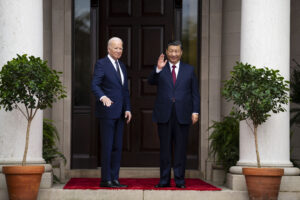40 Years After ‘The Day After’
The ABC made-for-tv film is a stark reminder that nuclear deterrence is a strategy that can and will fail someday. Jason Robards looks out at post-WWIII Kansas. Image: ABC
Jason Robards looks out at post-WWIII Kansas. Image: ABC
On Sunday, Nov. 20, 1983, I left my college dorm to visit my parents’ home in the suburbs of Oxford, Ohio. That evening, along with some 100 million other Americans, we witnessed two hours of stunning television that would mobilize the nation, as well as some of its leaders, to take meaningful steps to reduce the nuclear danger.
“The Day After,” shown on the ABC television network, took viewers into the lives of characters in typical towns and cities in the midwestern United States, not far from U.S. nuclear-armed intercontinental ballistic missile (ICBM) silos. Following a fictional NATO-Russia military confrontation that spun out of control, the film showed the shocking effects of an all-out nuclear exchange designed to hit “military and related-industrial targets” and the catastrophic aftermath.
The film remains a devastating reminder that nuclear deterrence is a strategy that can and will fail someday. It fueled criticism of the Reagan administration’s aggressive nuclear buildup and added momentum to the powerful public movement demanding that U.S. and Soviet leaders freeze and reverse the arms race. It spurred concerned citizens into action. It inspired me to help form a chapter of United Campuses Against Nuclear War at Miami University.
Four decades later, as a result of landmark bilateral nuclear arms reduction agreements, Russian and U.S. Cold War nuclear stockpiles have been reduced drastically, but continue to pose an existential danger. Russia and the United States still cling to Cold War-era nuclear doctrines and deploy thousands of high-yield nuclear warheads on hundreds of ICBMs, designed to annihilate each other’s military and command capabilities within 30 minutes of a presidential launch order.
The film remains a devastating reminder that nuclear deterrence is a strategy that can and will fail someday.
A new study by Princeton University researchers in Scientific American this month documents the effects of a nuclear attack from Russia on the 450 U.S. ICBM silos located in North Dakota, Montana, Wyoming, Colorado, and Nebraska. These high-yield nuclear detonations would rain lethal fallout on several million people in the first hours, with tens of millions more people dying of radiation sickness thereafter—the same scenario as the 1983 film. Depending on weather patterns, more than 300 million people in the continental United States, the most populated areas of Canada, and northern Mexico would be at risk of lethal fallout.
The Pentagon’s official rationale for the U.S. ICBM arsenal is to force China or Russia to direct a large portion of their long-range nuclear forces at U.S. ICBMs to try to limit the damage that they would suffer from a U.S. nuclear counterstrike. Because the bulk of the U.S. ICBM force would be destroyed in a large-scale nuclear attack, it remains U.S. policy to keep the ICBMs on prompt alert to allow for “launch under attack.” This gives the president mere minutes to decide whether to authorize the use of ICBMs, which increases the risk that a false alarm or misinformation could trigger a nuclear catastrophe.
A large ICBM force hair-trigger alert is not only dangerous, but also pointless. The United States has more than 1,000 nuclear warheads on invulnerable strategic ballistic missile submarines at sea and long-range nuclear-armed bombers that can be airborne ahead of a surprise nuclear attack. Just one U.S. nuclear-armed submarine, carrying 160 thermonuclear warheads, each with an explosive yield of 100 kilotons TNT equivalent or more, could devastate a large country and kill tens of millions of people. The United States maintains eight strategic subs on continuous patrol. Furthermore, U.S. ICBMs, which likely are targeted against Russia’s land-based strategic rocket forces, would be hitting empty silos because Russia’s ICBM forces also would be launched on warning of a U.S. retaliatory attack if they were not already part of a Russian first strike.
Nevertheless, the United States has initiated a program to replace its existing Minuteman III missiles with 666 newly designed Sentinel ICBMs, 400 of which would be deployed through 2070 at a cost in excess of $150 billion. That assumes, incorrectly, that the United States needs to have 400 ICBMs for the indefinite future. Presidents can change outdated military requirements, and future arms reduction agreements certainly can reduce the number of ICBMs or, better yet, eliminate them altogether.
Amid the catastrophic destruction of “The Day After,” one character, a woman about to give birth, complains to her doctor, “We knew the score. We knew all about bombs. We knew about fallout. We knew this could happen for 40 years. But nobody was interested.”
We may not be so lucky to avoid nuclear Armageddon for another 40 years. Once again, our survival depends on more interest, more public engagement, and more pressure on policymakers to turn away from dangerous nuclear deterrence policies of the past. We must push leaders to reengage in disarmament negotiations to reduce the risks, the role, and the number of nuclear weapons, beginning with ICBMs.
Your support matters…Independent journalism is under threat and overshadowed by heavily funded mainstream media.
You can help level the playing field. Become a member.
Your tax-deductible contribution keeps us digging beneath the headlines to give you thought-provoking, investigative reporting and analysis that unearths what's really happening- without compromise.
Give today to support our courageous, independent journalists.






You need to be a supporter to comment.
There are currently no responses to this article.
Be the first to respond.